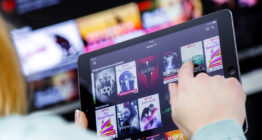Analysis: Unpacking the changing dynamics of television consumption

Subscribe to NewscastStudio for the latest news, project case studies and product announcements in broadcast technology, creative design and engineering delivered to your inbox.
Television, once the province of nightly appointment viewing, has seen a seismic shift in the last decade. The rise of streaming services has changed the game, ushering in what many have termed the “golden age” or “peak TV.”
However, according to recent market research and surveys of the media landscape, that golden age is nearing its twilight and a plateau in growth is seemingly upon us.
For example, Hub Entertainment Research’s “Monetization of Video” finds that consumers appear to have hit their limit for television sources.
The research suggests that most viewers are not seeking to expand their list of entertainment subscriptions. In fact, about half of the respondents revealed they had reached their saturation point. Yet, even as consumers are reluctant to add more services, the industry may find solace in another intriguing finding: television and streaming media spending continues to rise.
Around 44% of surveyed consumers admitted they are spending more on television and streaming services than they did the previous year. This increase is notable, considering it’s also up from 34% in 2020. The rise is even more significant when one observes the discrepancy between what consumers consider a “reasonable” amount for video services and their actual expenditure. The average monthly spending of $85 exceeds what they deem “reasonable” by 25%.
Although a saturation point appears to be reached in the number of sources, there is clearly room for growth in spending. That brings us to the question of value and how consumers perceive it.
As the Hub Entertainment Research report suggests, this might be where bundling comes into play. The research highlights that for viewers without a Multichannel Video Programming Distributor (MVPD) subscription, a combination of Subscription Video On Demand (SVOD) services with traditional Pay TV services could provide a perceived increase in value.
66% of these consumers stated that such a bundle would make a Pay TV service more appealing to them, a jump from 59% the previous year. This consumer sentiment hints at a potential avenue for providers to mitigate the challenge of subscription churn and cancellations.
The fact that one in four adults recently canceled a streaming service is a stark reminder for streaming platforms about the transience of subscriber loyalty. The industry must work harder to justify its costs by delivering consistent, high-quality and diverse content. Sure, not every show can be a prestige drama – but not every show needs to be from the XYZ cinematic universe.
Meanwhile, an alternate study conducted by Samba TV, focusing more on viewership intelligence, notes a different facet of this evolving landscape. According to their survey, most new subscribers to ad-supported streaming video plans are first-time customers.
The industry is experiencing a surge from a new breed of streamers, not just cord-cutters or downgraders.
This insight becomes even more intriguing when we consider the specific findings. For instance, of the Netflix subscribers surveyed, 11% chose the Netflix basic plan with ads. However, a significant 85% of these users joined Netflix only after the company introduced this ad-supported tier. The same pattern is seen with Disney+ subscribers, with 85% of those picking the basic plan with ads.
These statistics point towards an industry undergoing a fundamental shift in its customer base and its preferences but the changing landscape does not assure unwavering loyalty.
According to yet another recent survey, this time by DirecTV Advertising, a considerable chunk of U.S. adults (one in four) had canceled a streaming video service within the past three months. The most cited reason – mentioned by 35% of respondents – was inadequate usage of the service to justify its cost.
We’re all more busy than ever and it does beg the question, where does content fit into our lives and how much do we need?
The study from DirecTV found that virtual MVPDs like DirecTV Stream were used more frequently than Subscription Video On Demand (SVOD) platforms. In May, viewers aged 25-54 spent twice as much time with DirecTV’s streaming services each week compared to Netflix.
While we observe these changes and disruptions, Nielsen’s The Gauge report offers a bird’s-eye view of television consumption patterns.
According to their most recent data, streaming platforms bounced back in May 2023, capturing 36.4% of all television viewing, a 2.5% increase from April. Some of this growth is credited to a change in their methodology, which now more accurately attributes the viewing of streaming originals via cable set-top boxes to the streaming category.
Furthermore, The Gauge’s latest report also highlights the burgeoning prevalence of free ad-supported television (FAST) services.
Take, for instance, The Roku Channel, which secured 1.1% of total TV usage in May. It’s not just The Roku Channel, though; collectively the three FAST services covered in The Gauge – Pluto TV, Tubi TV, and the Roku Channel – command viewership equivalent to Peacock and Max. even surpassing Amazon Prime Video’s viewership.
This trend reinforces the idea that not all viewers are willing or able to pay for multiple streaming subscriptions and free or cheaper alternatives have a significant role in the evolving marketplace – especially with password sharing crackdowns and changing account dynamics.
However, while the growth of FAST services is notable, it pales compared to the viewership of local broadcast news, which outpaces streaming platforms by a staggering 8-12 times. Despite advances in technology and changes in consumer habits, local news remains a cornerstone of our media consumption. As providers strategize to adapt and evolve, they would do well to take cues from the enduring appeal and resilience of local news.
Many interconnected threads or trends between these various surveys point to an evolving media landscape that continues to be redefined.
First, it’s clear that consumer appetite for streaming content, while significant, is approaching saturation. Paradoxically, they are spending more on these services, often exceeding their own expectations of “reasonable” costs. This suggests that the perceived value delivered by these platforms remains high and viewers are willing to pay for a variety of content that suits their tastes (or maybe they just have not paid attention to their bill recently?).
The challenge for providers will be to sustain and enhance this value in a market where consumers are unwilling to expand their portfolio of sources, which likely leads us to some consolidation as growth continues to wane.
Second, the rise of ad-supported plans indicates a new trend in consumer preferences. There’s an apparent appetite for more affordable, flexible viewing options, evidenced by the influx of first-time subscribers these ad-supported plans are attracting. With traditional TV broadcasters like Netflix and Disney+ adopting such strategies, we could expect other players to follow suit, creating a new norm in the industry and basically returning us to basic cable but via a new delivery method.
Lastly, the enduring dominance of local broadcast TV news is an interesting contrast to the rapid rise of digital streaming. This disparity suggests that despite the allure of digital platforms, consumers still value timely, localized news content, presenting an untapped opportunity for digital platforms to localize their offerings. Yet every time we see a major broadcaster try and create a digital-focused news offering, it feels largely uninspired.
As the industry continues to evolve, providers must remain nimble and responsive to these changing dynamics to thrive in the new era of television consumption.
While the “golden age” of peak TV may be sunsetting, these emerging trends, shifts and challenges open up new paths for the industry. The advent of a new breed of streamers, the rise of FAST services and the willingness of consumers to spend point to an industry that’s far from stagnation… but opportunities for growth and expansion abound only for those who can skillfully navigate this ever-changing terrain.
Subscribe to NewscastStudio for the latest news, project case studies and product announcements in broadcast technology, creative design and engineering delivered to your inbox.







tags
Free Ad Supported Television (FAST), streaming, Subscription Video on Demand
categories
Broadcast Industry News, Heroes, Market Research Reports & Industry Analysis, Thought Leadership, Voices